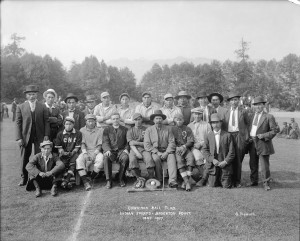Written by guest bloggers, Allan Downey and Susan Neylan.
 Photo taken by Stuart Thomson, May 1917: “Cowichan Ball Club – Indian Sports – Brockton Point”. Courtesy of the Vancouver City Archives
Photo taken by Stuart Thomson, May 1917: “Cowichan Ball Club – Indian Sports – Brockton Point”. Courtesy of the Vancouver City Archives
This past February the All-Native Tournament, an annual basketball competition held in Prince Rupert, BC, received national press coverage (click here to view story from CBC News) (click here to view story from the Globe and Mail) over a controversy regarding the exclusion of a young basketball player. The issue concerned the participation of a 20 year-old point guard on the Heiltsuk Wolf Pack Team who was denied the opportunity to compete because he doesn’t have First Nations biological ancestry. The athlete was adopted as an infant in Haiti and raised as a member of a Heiltsuk First Nation. Although adoption is a long-standing tradition among Indigenous people in the region and he is a Status Indian under Canadian law, tournament organizers insist that bloodlines are the determining factor for eligibility (participants must have at least 1/8th First Nations blood), and banned him from play. This case raises questions about sport and the constructions of race and Indigenous identity within the colonial borders of Canada relevant to our recent article about nineteenth-century Indigenous sport in colonial-controlled spaces.
To understand the roots of these discussions of Indigenous identity that embrace both Indigenous and colonial frameworks, we need to consider the earlier history of how identities in sport have been defined, and by whom. Whether athletic competitions categorized by race at agricultural fairs, or seasonal matches between rival Indigenous teams, First Nations’ experiences playing western sports reveal “change in continuity, [and] the continuity in change”[1] for Indigenous physical culture. In “Raven Plays Ball” we explore the uses of Western sports as mechanisms that reinforce colonial assimilationist agendas but that simultaneously acted as Indigenous-controlled spaces that upset those colonial agendas. Up and down BC’s coast throughout the first half of the 20th century, “Indian Sports Days” and sport organizations provided many examples of Indigenous communities adopting sports introduced by colonial agents —baseball, soccer, or even appropriated forms of lacrosse — and recasting them as Indigenous expressions based in their own worldviews, traditions, and sporting practices.
[1] This phrase is borrowed from Keith Thor Carlson’s The Power of Place, the Problem of Time (Toronto, 2010), 80.
Allan Downey and Susan Neylan’s article, “Raven Plays Ball: Situating “Indian Sports Days” within Indigenous and Colonial Spaces in Twentieth-Century Coastal British Columbia” appears in the latest edition of the Canadian Journal of History/Annales canadiennes d’histoire. Read it today on at CJH/ACH Online – http://bit.ly/CJH503_DowneyNeylan Project MUSE – http://bit.ly/CJH503PMc.
Comments on this entry are closed.